Now that jazz is achieving respectability in educational circles and analysts are applying their diverse techniques to improvised solos, it is appropriate to review what is being done in jazz analysis and to suggest a direction for the future. The three purposes of this article are: to present an overview of several methods for analysis of improvised jazz, including bibliographic references for further study; to introduce an analytic format which approaches a synthesis of aspects of these methods; and to apply that format to a classic solo, both to demonstrate the format and to acquaint the reader with a fine piece of music to share with students.
Overview of Various Approaches to Jazz Analysis
downbeat magazine was regularly publishing transcriptions and analyses of jazz solos by the early 1950s.1 One early analytic tool would relate each pitch of a solo to the root of the chord in effect as that note is played (for example, noting a melodic leap from the 7th to the augmented 11th of a particular chord). Problems arise immediately in deciding which chords to use as reference points. The "original" chord changes (harmonic progression)? There may be no authoritative set of changes. The progression played by piano and bass? They may not even agree with one another, and the soloist may not always be relating to either of them. The changes the soloist is "thinking" as made evident in the solo itself? Trying to recreate the soloist's thought process is difficult and dangerous. Nevertheless, even with these problems, the attempt to relate melody to the underlying harmony in this way has proved useful to improvisation students and is still important in jazz education.
Often it is even more useful to show the relationship between a longer melodic passage and the underlying harmony than to deal with each note individually. For example, pointing out that a passage of music over an E-flat major seventh chord "uses the E-flat lydian mode" summarizes the pitch material and ties in well with the chord-scale correlation approach of many jazz improvisation courses.
A second approach to analysis of jazz solos entails recognition of the fact that many solos seem to be constructed not in terms of notes or scales prompted by a certain chord, but in terms of complete melodic patterns or formulas which can fit a chord or series of chords. Jazz writers have long pointed out that most players reuse musical ideas from solo to solo, to one extent or another. But it was Thomas Owens who made it clear just how pervasive formulas could be in the solos of Charlie Parker. Owens's dissertation, a labor of love which included some 250 transcriptions, catalogued the appearance of about 100 formulas which Parker reworks solo after solo.2 Such evidence of formula playing in perhaps the greatest of jazz improvisers suggests that formula identification and cataloguing is a fruitful analytic pursuit. And it also adds a new aspect to improvisation pedagogy: the student learns not only scales which fit various chords, but also a series of melodic formulas which can be plugged into appropriate spots in the chord progression.
Recent jazz writers have noted the similarity between this sort of formulaic jazz improvisation and a kind of poetry in which a story-teller relies on often-used phrases when retelling a poem which has not been fixed into written form. Borrowing from analysts of Homer's epic poems, jazz analysts have applied some of their techniques to improvised solos.3 Some of the problems in poetic analysis have carried over into music analysis as well, however. In both areas it has proven to be difficult to decide exactly what qualifies as a formula. Must it be of a certain length? Must it be sufficiently unique to be recognized as a formula? How does one decide whether a certain musical idea is one long formula or two shorter formulas? Gregory Smith, in his dissertation on Bill Evans,4 discusses these problems and determines formulas primarily according to direction of motion (up or down) from one tone of "relative stability" to another. In one solo alone he identifies 190 formulas which he then divides into categories about which generalizations can be made and conclusions drawn.
Barry Kernfeld has circumvented the problem of delineating specific "formulas" by identifying "formulaic networks" in a solo or solos.5 Using an ingenious and informative display, Kernfeld clearly shows recurrent patterns without having to define the formula. Although a complete explanation is beyond the scope of this article, Figure 1 sums up formulaic playing by John Coltrane in one solo consisting of 22 blues choruses. In all, Coltrane plays B-flat-C-D-(E-flat)-F in eighth notes 36 times in this solo. The figure also shows that the context of that pattern—the two or three beats on either side—varies rather little as well.
Figure 1. Barry Kernfeld: Formulaic Recurrence Table for a John Coltrane Solo6
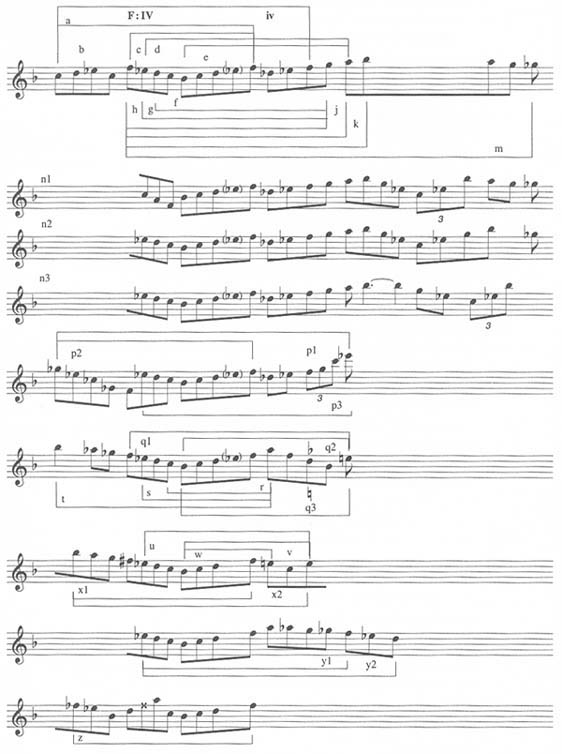
Other writers have discussed pattern terminology, distinguishing among "formula," "motive," and "lick."7 One point still seems as clear now as it did when Owens's dissertation appeared: many jazz improvisers do make use of recurrent melodic ideas, and a study of these recurrences leads to clearer understanding of the improvisation process, helps us understand coherence and continuity in a solo (or in several solos of the same musician), or possibly exposes uncreative redundancy in a solo. It can therefore be an important aspect of jazz analysis.
A third analytic approach applies Schenker's analytic techniques to jazz solos. In a recent dissertation Steve Larson makes a strong case for the applicability of Schenkerian analysis to improvised jazz.8 Some analysts would never look for the kind of relationships Schenkerian analysis might uncover, assuming that instantaneous composers—improvisers—cannot be expected to think in such long-range terms. But Larson demonstrates that the best improvisers do indeed have this capability, and he cites a Bill Evans solo and Evans's discussion of the solo to prove it.
Larson is not alone in applying Schenkerian techniques to jazz improvisation. Milton Stewart has studied Clifford Brown's style from a Schenkerian perspective,9 and Thomas Owens has included several Schenkerian graphs of Charlie Parker solos in his previously-mentioned dissertation.
A fourth approach also uses reductive techniques. Kent Williams applies implication-realization theories of Leonard Meyer and Eugene Narmour10 to bebop "heads" (composed melodies) noting that bebop improvisations differ little from bebop heads. Simplifying Meyer and Williams greatly, various musical gestures carry the seeds for their continuation. Scalewise motion often tends to continue in the same scalar direction to a point of stability. Melodic leaps may be the beginnings of arpeggiated chords or they may be gaps which imply a scalewise "fill" of that musical space in the opposite direction. Whatever the implication of a gesture, the realization of that implication may or may not take place; that is, the listener's expectation may or may not be fulfilled, or the expectation may be fulfilled after a delay.
Figure 2 diagrams a network of interlocking implication-realization patterns. While Williams's graphing techniques cannot be discussed in detail here, notice that the gap  -F in m. 1 is filled in by the scale passage completed in m. 5. Then another gap almost reaches "satisfactory" closure on G (mm. 5-8), but stops short on
-F in m. 1 is filled in by the scale passage completed in m. 5. Then another gap almost reaches "satisfactory" closure on G (mm. 5-8), but stops short on  . That implied G is left unrealized until m. 15 when its appearance also represents closure (or realization) for two separate linear descents. Thus that G represents the simultaneous realization of three different implications reaching as far back as m. 5.
. That implied G is left unrealized until m. 15 when its appearance also represents closure (or realization) for two separate linear descents. Thus that G represents the simultaneous realization of three different implications reaching as far back as m. 5.
Figure 2. Kent Williams: Analysis of Bud Powell's "Wail"11
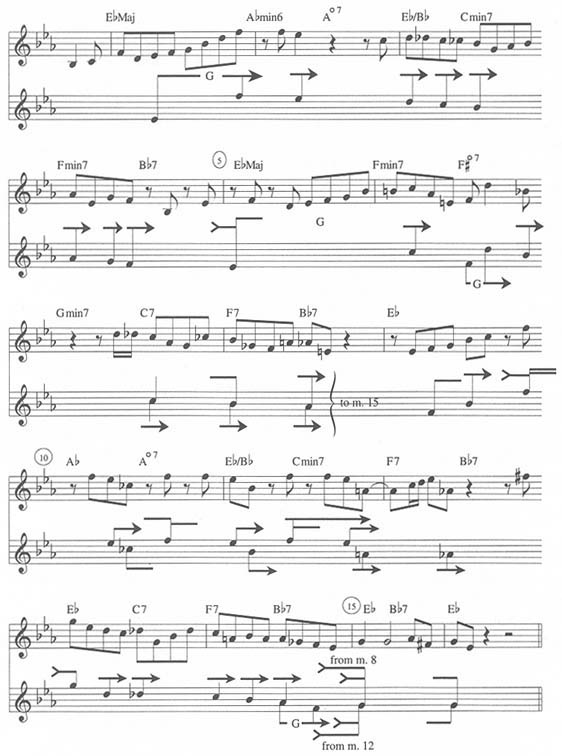
A fifth approach to analyzing improvised jazz involves similarities between jazz and spoken language. Although drawing parallels between music and language is a dangerous pursuit, Alan Perlman and Daniel Greenblatt have put forth several provocative ideas.12 For example, the structural levels in various language theories may have analogues in jazz; deep, shallow, and surface language structures may respectively be seen to parallel underlying harmonies, various scale possibilities which "fit" the harmonies, and the particular solo itself. II-V-I harmonic patterns nested within other II-V-Is—common bebop harmonic patterns—are similar to embedded phrases in sentence structures. Quotations may be seen to play similar roles in jazz and language. And, just as one must know a language to understand a speech in that language, one must learn the jazz language to fully understand jazz improvisation. Perlman and Greenblatt point out, however, that there are "inside" and "outside" jazz audiences for whom a given solo has different kinds of significance, "as it may be meaningful in some way for us to hear an impassioned—but untranslated—speech by the prime minister of Japan, especially if we see and hear it in its original context."13
While such parallels between spoken language and improvised jazz are fascinating—and Perlman and Greenblatt present many more—a successful application of linguistic techniques to jazz analysis has, to my knowledge, yet to be made. One writer takes a linguistic approach in an attempt (largely unsuccessful) to demonstrate that, by quoting melodic fragments from pieces with lyrics, improvising instrumentalists can and sometimes do communicate specific verbal information to audience members, literally "telling stories" in their solos.14
A sixth approach involves pitch class set analysis. In Pitch Class Set Structures in Contemporary Jazz,15 Jeff Pressing applies set analysis to such diverse collections as vertical structures in a Thad Jones arrangement and melodic segments in a John Coltrane improvisation. In a recent presentation entitled "Pitch Class Transformation in Free Jazz," Steven Block demonstrates that pitch set analysis can be an effective tool in understanding improvisations of Cecil Taylor, Ornette Coleman, Anthony Braxton, and others.16
Toward a Synthesis
Certainly there are variations on all these approaches to jazz analysis and probably some quite different approaches as well. In any case, the preceding are interesting and informative; all of these focused approaches ought to be pursued, applied to many solos, and their results made available to interested listener-readers. I wish to suggest, however, that there is a need for a kind of analysis which draws upon various focused analytic approaches, combining them into a single presentation. An analysis of a particular piece might ultimately concentrate on one or two of the individual approaches, but initially it should be broad enough to consider them all, open to the great diversity among improvised solos. Different solos are prized for different reasons. A list of positive improvisation characteristics contains diverse and even contradictory attributes. For example, it would not be difficult to think of a solo or soloist valued for each of the following:
Great speed
Wide range (particularly high range)
Tremendous endurance
Beautiful legitimate tone and flawless intonation (or)
Wonderfully bizarre and unique sound; unusual approach to intonation
An excited, propulsive, on-top-of-the-beat feel (or)
A loose, relaxed, laid-back feel
Showing empathy with past eras of jazz (or)
Being novel, original, non-derivative
Quoting often and effectively (or)
Refusing to "mar" the solo by "sudden quotation"17
Showing restraint and classical balance (or)
Making expressive use of growls, honks, squeaks, and split tones
And this is just the start of a long list. David Baker, in a series of monographs analyzing the music of Cannonball Adderley, Clifford Brown, Fats Navarro and others, does take into consideration many seldom-discussed features.18 He employs a standard two-page form on which the features are listed; the analyst checks off those features present in a given solo.
Many factors may contribute toward making an improvised solo "good" or "great." A solo which shows little motivic or formulaic coherence, or which will not reduce to a Schenkerian model, or which leaves implications unrealized may nevertheless be a great solo for other reasons, reasons harder to theorize about or harder to uncover by applying one specific analytic methodology. Although there is a place for analysis in which one method is applied exclusively, the analyst must realize that it provides only a single view.
Any music analyst needs to ask two questions: Why analyze this music? And for whom is my analysis intended? My answers to these questions determine the direction of the rest of this article. Why analyze jazz? Jazz deserves to be studied because, at its best, it is glorious music, worthy of appreciation on all levels including the intellectual. For whom is my analysis intended? Any fairly well-trained listener-reader, whether jazz lover or not, particularly the musician who may have little exposure to jazz and who can be guided to greater understanding and, therefore, greater appreciation.
With these answers in mind, my analysis strives to adhere to three guidelines as closely as possible:
(1) The analytic perspective should be eclectic, holistic, using whatever approaches help explain a solo's effectiveness.
(2) The improvised solo should be transcribed in "playable" notation, that is, without elaborate additional symbols which can clutter the notation by striving to include every expressive nuance.
(3) As much of the analysis as possible should be displayed in musical notation. Some verbal description is inevitable, but it should be kept to a minimum.
I try to present as much information as possible in notation aligned with the solo itself. A four-line score works well, at least for preliminary work.19 The top line is the transcribed solo, at concert pitch rather than in the key of the solo instrument. Chord changes are indicated above the solo. Again, it can be difficult to decide which changes to indicate; those of the rhythm section players carry some weight as do changes implied by particular pitch patterns of the soloist. Published or "fake book" changes are considered, but suspiciously. Ultimately, chord choice may be a compromise or an educated guess. This top line may also be used to indicate the relationship of individual pitches to chord roots or use of certain scales, but nothing should obscure the solo itself.
The second line focuses on pitch continuity, particularly repeated pitches, resolutions of tendency tones, and stepwise motion at the "middleground" level. Schenker and Meyer inform the approach but are not followed strictly. Where short-range pitch continuity seems to disappear, nothing appears on that line. There is no need to manufacture a continuity or coherence which does not exist.
The third line deals with motivic patterns. It might display any of the following:
(1) Motives from the head which are woven into the solo.
(2) New motives which are repeated and developed.
(3) Formulas (recurrent melodic patterns of various lengths). I seek recurrent patterns only within a single solo and make no attempt to relate them to the soloist's overall style. Nothing would preclude taking a broader perspective, but an analyst can generalize about overall style only after studying a substantial percentage of an improviser's recorded output.
(4) References to the original melody or quotations from other sources, which can alternatively be indicated on the top line, provided they do not clutter the transcription itself.
An optional fourth line in my preliminary score allows for inclusion of any other matters for which musical notation or a brief comment would be clearer and more immediate than a separate verbal statement. Various rhythmic and expressive features might appear here.
Separate tables or notated reductions could be added, but only if the same information could not as effectively be presented parallel to the transcription. A danger in placing so much emphasis on musical notation in the analysis is that important but hard-to-notate features may be ignored. A brief narrative mentioning such features, highlighting important aspects of the notational analysis, and perhaps drawing conclusions, is therefore usually part of the analysis as well.
The value of this analytic format can best be demonstrated by listening to a solo several times while studying the notational analysis. Each successive hearing brings the listener-reader closer to an understanding of the analyst's view as to what makes the solo effective. The eye of the listener-reader moves easily among the solo and analysis lines. Shifts from one analytic tool to another are easily visible; indeed, they suggest tactical changes in the improviser's approach as well.
The following sample analysis begins with a brief verbal summary of a legendary improvised solo by Julian "Cannonball" Adderley. Figure 3 presents the original melodic material. My transcription of the improvisation itself along with the majority of the analytic information are presented in Figure 4.
Sample Analysis
In a classic recording of Thelonious Monk's Straight, No Chaser, Cannonball Adderley improvises on alto saxophone over five choruses of the standard twelve-bar-blues chord progression; pauses at or near the end of each chorus divide the improvisation into five almost equal sections, and the individual choruses are further divided—by rests for breaths—into two to five phrases each. In spite of the quick tempo, the soloist's rhythmic approach is relaxed, often "laid-back" (slightly behind the pulse of the rhythm section). In portions of all but the fourth chorus, Adderley's melody moves primarily in sixteenth-notes; these flowing and relaxed "double-time" sections demonstrate absolute technical control of the instrument and provide vivid contrast to the primarily eighth-note motion of the rest of the solo. Rhythmic mastery and inventiveness are strikingly demonstrated by an area in the second chorus (mm. 6-8) in which accented notes create an implied 3/8 meter against the 4/4 of the rhythm section.
References to the "head" (Monk's composed melody), at least its structural pitches, occur frequently: at the beginning of choruses 1, 3, 4, and 5, and also at the end of the last chorus.
Figure 3. Thelonious Monk, "Straight, No Chaser," principal melodic material

The third line of the analysis (Fig. 4) shows these references as well as motivic patterns which recur during the solo. A four-note pattern, labeled "a," is common—particularly in the double-time sections.20 More important, several longer patterns recur virtually intact at different points in the solo, usually at points where the harmonic progression recurs as well. For example, in mm. 7 and 8 of both the third and fourth choruses, a long pattern appears almost without alteration. In another instance, m. 11 of the first chorus and mm. 6 and 7 of the second are similar in pitch but varied rhythmically. The third line of the analysis also shows how a well-known melodic fragment from an improvisation recorded by Charlie Parker thirteen years earlier is quoted, extended, and varied at the start of the fourth chorus. Coherence in the solo is increased both by references to the head and by other recurrent patterns, all shown on the third line.
A different kind of coherence is clear from the second line. Large portions of the solo can be perceived as elaborated scale passages—step progressions—which are indicated on the second line either with connecting beams or dotted lines. The first six measures of the improvisation demonstrate this clearly as do all twelve measures of the third chorus in which a scale begins on a high  (m. 2) and falls two octaves in ten measures.21 Few emphasized pitches in the entire solo are left unresolved. Most are, within a measure or two, heard to move stepwise to another important pitch. The double-time areas show less of this kind of stepwise organization, however. One might speculate that a different improvisational aesthetic comes into play in these areas—more technical, displaying more emphasis on the sweeping gesture than on individual notes, perhaps representing a higher heat-to-light (emotion-to-intellect) ratio. Pattern repetition is correspondingly more prevalent in these double-time areas.
(m. 2) and falls two octaves in ten measures.21 Few emphasized pitches in the entire solo are left unresolved. Most are, within a measure or two, heard to move stepwise to another important pitch. The double-time areas show less of this kind of stepwise organization, however. One might speculate that a different improvisational aesthetic comes into play in these areas—more technical, displaying more emphasis on the sweeping gesture than on individual notes, perhaps representing a higher heat-to-light (emotion-to-intellect) ratio. Pattern repetition is correspondingly more prevalent in these double-time areas.
Remarkably, in spite of the large number of improvisational techniques employed in just sixty measures—reference to the head, quotation, and pattern repetition, all performed with great rhythmic diversity—there is no sense that the solo is a disconnected series of ideas resulting from a confused assortment of improvisational tactics. On the contrary, there is a feeling of balance and controlled momentum. The music "breathes," particularly as Adderley moves between eighth- and sixteenth-note sections, explores the entire range of the saxophone, and at several places (e.g., the first four measures of the fifth chorus) "plays outside,"—i.e., deliberately choosing pitches at odds with the operative chord progression. And although the five choruses are not unified by a single idea, Schenkerian or otherwise, Adderley's solo is a single, unified musical statement. The last few measures return to the eighth-note pace, the range, and even the structural pitches of the solo's beginning. The final four notes in particular reflect the opening gesture, and the solo ends, satisfyingly, much as it began.22
Figure 4. Transcription and analysis by the author of Cannonball Adderley's Improvised Solo on "Straight, No Chaser."23
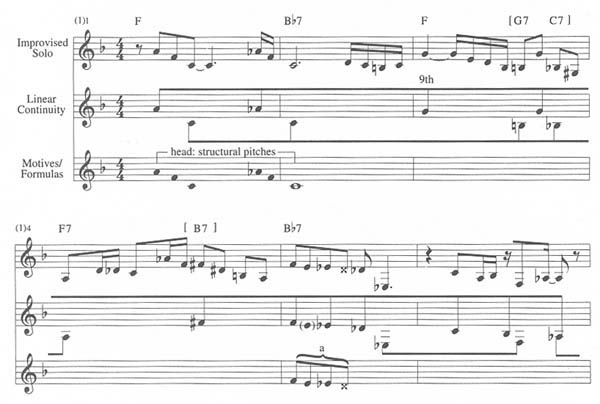
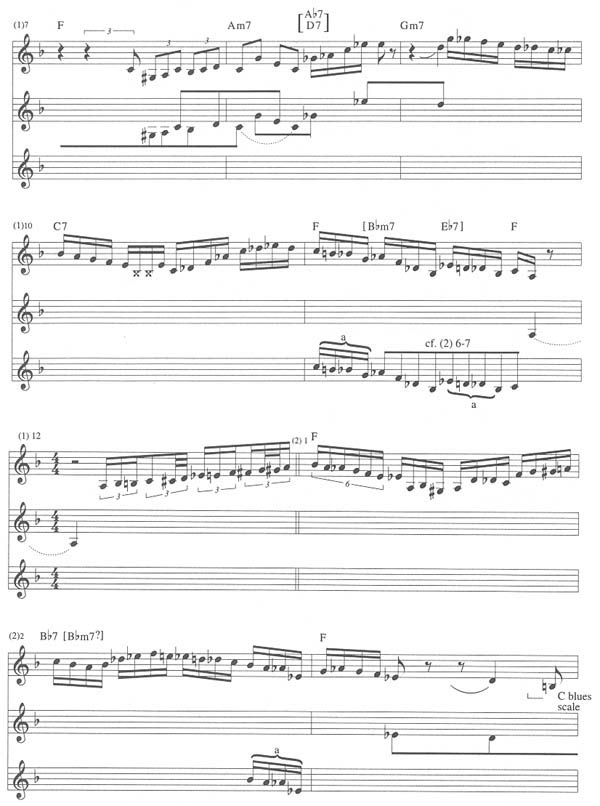
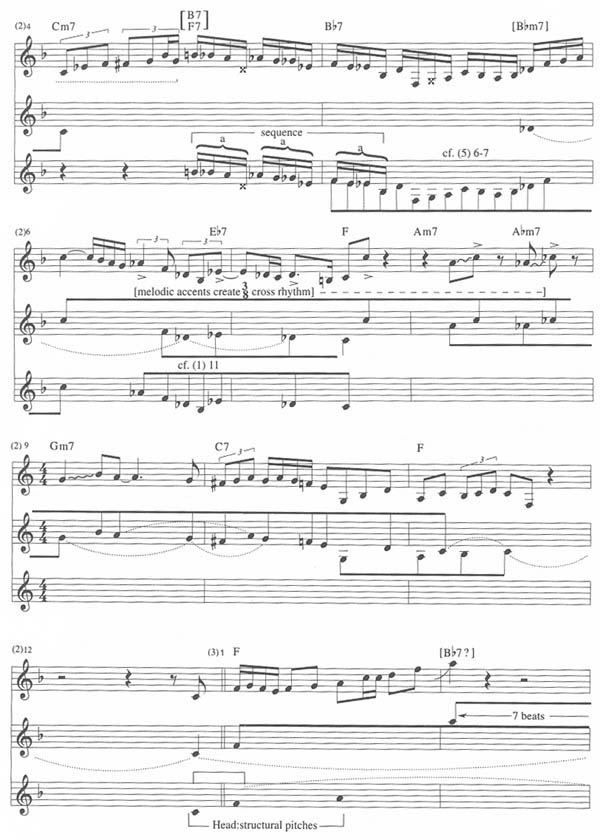
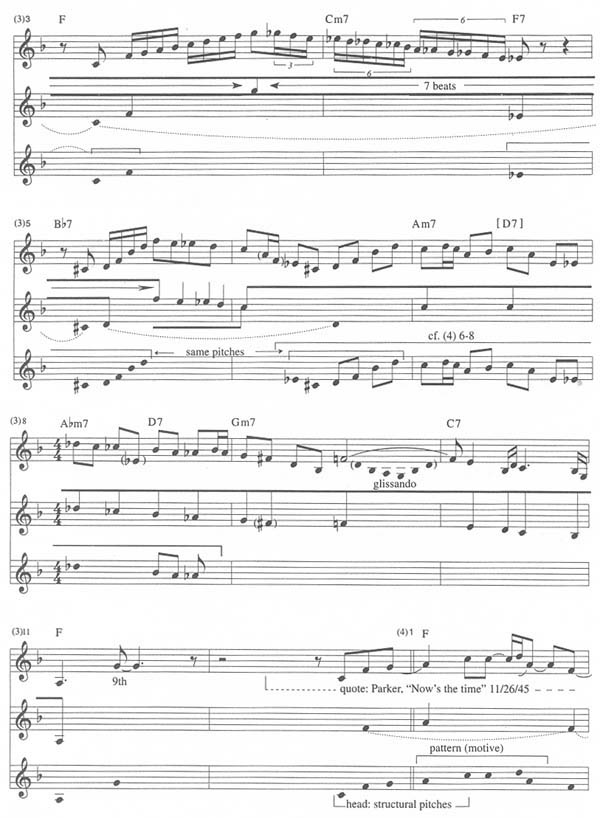
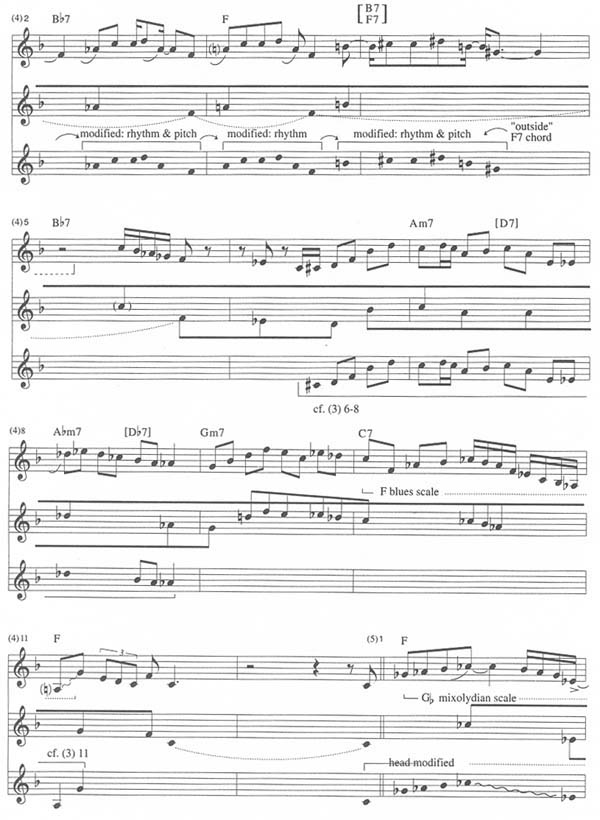
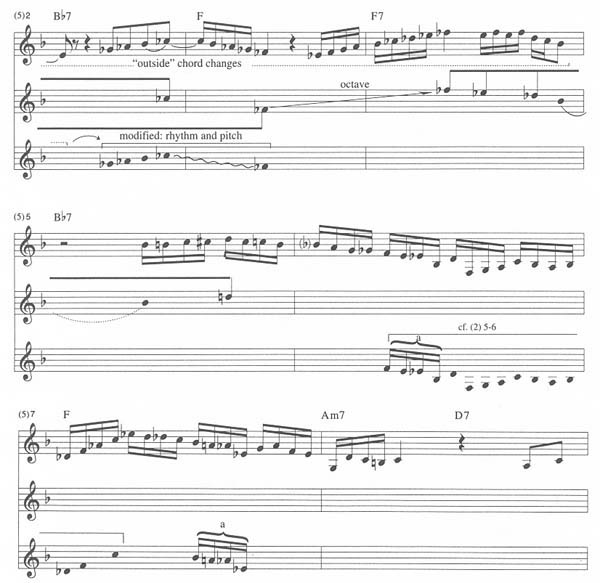
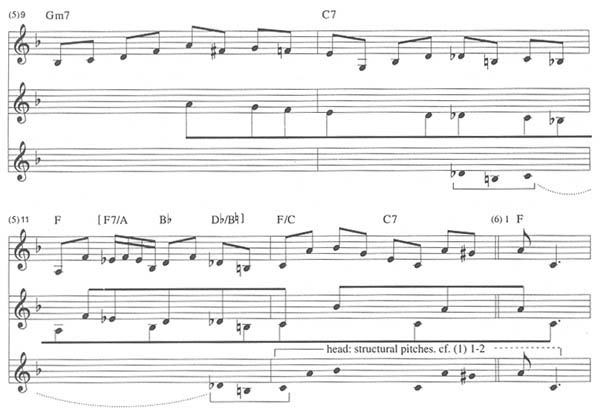
Conclusion
Analysis of improvised jazz is still in its infancy. Various analytic approaches mentioned in this article have begun to illuminate the music, and other as yet undiscovered analytic techniques will undoubtedly contribute to our understanding. Meanwhile, a broader analytic approach is also needed, one which draws upon the various focused approaches and presents the music and its explanation to interested listener-readers, including musicians who lack extensive jazz backgrounds. Too often, non-jazz music teachers and students assume that jazz is esoteric, that one needs years of study and perhaps even a special sort of talent to appreciate it fully. Too often, jazz lovers themselves have encouraged this assumption, enjoying status as the privileged few able to understand such difficult music. In fact, jazz music is, for the most part, not at all difficult, and the best jazz quickly rewards study. Jazz lovers have an obligation to share their music. College music teachers in particular should be given the opportunity, in part through clear broad-based analyses, to understand it themselves and pass their understanding on to others. Generations of music students must not be allowed to miss the beauty and depth of this uniquely American music.
This article is re-printed from Volume 30. It was edited for that volume by Margaret M. Barela.
1See Bill Russo and Lloyd Lifton, "Jazz Off the Record," an irregular series beginning with Vol. 17, No. 1 (January 13, 1950). I am indebted to Barry Kernfeld, editor of the New Grove Dictionary of Jazz, for reminding me of a column by Sharon Pease which appeared regularly in downbeat from April 1937 through the 1940s. Each column contained a pianist's biography, a notated piano solo, and often a few analytical comments as well.
2Thomas Owens, "Charlie Parker: Techniques of Improvisation" (Doctoral diss., Univ. of California at Los Angeles, 1974).
3For jazz analysis relying heavily although not exclusively on formula identification, see Lawrence Gushee, "Lester Young's 'Shoeshine Boy,'" in International Musicological Society, Report of the Twelfth Congress, Berkeley, 1977, (Kassel, 1981). See also Barry Kernfeld, "Adderley, Coltrane, and Davis at the Twilight of Bebop: The Search for Melodic Coherence (1958-59)" (Doctoral diss., Cornell Univ., 1981). Sources on formulaic composition in literature include Ruth Finnigan, Oral Poetry: Its Nature, Significance and Social Context (Cambridge, 1977); Albert B. Lord, The Singer of Tales (1960; reprint, New York, 1965); and Milman Parry, The Making of Homeric Verse: The Collected Papers of Milman Parry, ed. Adam Parry (Oxford, 1971).
4Gregory Smith, "Homer, Gregory, and Bill Evans? The Theory of Formulaic Composition in the Context of Jazz Piano Improvisation" (Doctoral diss., Harvard Univ., 1983).
5Barry Kernfeld, "Two Coltranes," Annual Review of Jazz Studies 2 (New Brunswick, N.J., 1983), 7-66.
6Ibid., 26.
7See Lewis Porter, "Lester Leaps In: The Early Style of Lester Young," Black Perspectives in Music 9 (1981): 3-23. See also the formulaic approach incorporated into a broad eclectic study of Lester Young's music in Lewis Porter, Lester Young (Boston, 1985).
8Steven Larson, "Schenkerian Analysis of Modern Jazz" (Doctoral diss. Univ. of Michigan, 1987).
9Milton Stewart, "Some Characteristics of Clifford Brown's Improvisational Style," Jazzforschung/Jazz Research 11 (1979): 135-64.
10Leonard B. Meyer, Explaining Music: Essays and Explorations (Chicago, 1973); Eugene Narmour, Beyond Schenkerism: The Need for Alternatives in Music Analysis (Chicago, 1977); and James Kent Williams, "Themes Composed by Jazz Musicians of the Bebop Era: A Study of Harmony, Rhythm, and Melody" (Doctoral diss., Indiana Univ., 1982).
11Williams, 1, 211.
12Alan Perlman and Daniel Greenblatt, "Miles Davis Meets Noam Chomsky: Some Observations in Jazz Improvisation and Language Structure" in The Sign in Music and Literature, ed. Wendy Steiner (Austin, 1981), 169-83.
13Ibid., 181.
14Nicholas Strout, "I've Heard That Song Before: Linguistic and Narrative Aspects of Melodic Quotation in Instrumental Jazz Improvisation" (Masters thesis, Indiana Univ., 1986).
15Jeff Pressing, "Pitch Class Set Structures in Contemporary Jazz," Jazzforschung/Jazz Research 14 (1982): 133-72.
16Steven Block, "Pitch Class Transformation in Free Jazz," paper delivered at the annual meeting of the Society for Music Theory, Baltimore, November, 1988.
17Gunther Schuller, "Sonny Rollins and the Challenge of Thematic Improvisation," Jazz Review 1 (1958): 6.
18David N. Baker, The Jazz Style of Cannonball Adderley (Lebanon, Ind., 1980). See additional volumes in this series on Clifford Brown, Fats Navarro, John Coltrane, Miles Davis, and Sonny Rollins.
19There is certainly no necessity for using a 4-line display for every solo, although I have found it useful as a working format for new transcriptions. In a letter to the author in which he supports an eclectic analysis, Lewis Porter warns agains "a 'cookbook' approach to analysis. For me analysis is an inspirational, creative activity, like making music . . . . Every piece suggests its own approach . . . . I tend to resist any kind of standardized analysis where each piece will be presented along with a standardized chart or with the staff setup you suggest." And while Porter values "analysis that doesn't rely so heavily on words," he points out that his article on John Coltrane ("John Coltrane's 'A Love Supreme': Jazz Improvisation as Composition," Journal of the American Musicological Society 38 [1985]: 593-621) would have been less effective without substantial text.
20Gregory Smith, author of the previously-mentioned "Homer, Gregory, and Bill Evans? The Theory of Formulaic Composition in the Context of Jazz Piano Improvisation," argues persuasively that my pattern "a" should include a fifth note in each instance, and that it should be identified as a figure commonly used to embellish a descending third.
21Descending step progressions, such as this, are also seen as important contributors to melodic coherence in Charlie Parker's improvisations. See Peter K. Winkler, "Toward a Theory of Popular Harmony," in theory only 4 (1978): 3-26.
22For readers unfamiliar with the jazz chord symbols shown in Figure 4, capital letters indicate chord roots. "F" indicates a major triad on F. In practice pitches may be added when realizing a basic symbol; major sixths and ninths above the root are common additions to triads, and in blues-related pieces such as "Straight, No Chaser," minor sevenths are often added. The tonic chord "F" may thus be realized as an F major-minor seventh. When a major-minor seventh is specifically needed, an arabic 7 after the letter is used. " 7" is thus a
7" is thus a  major-minor seventh. "Am7" indicates a minor-minor seventh on A. In jazz, inversions are infrequently specified. When a specific inversion is needed, jazz symbols are cumbersome. In "Straight, No Chaser," F7/A indicates an F major-minor seventh with an A in the bass, i.e., in first inversion. Similarly
major-minor seventh. "Am7" indicates a minor-minor seventh on A. In jazz, inversions are infrequently specified. When a specific inversion is needed, jazz symbols are cumbersome. In "Straight, No Chaser," F7/A indicates an F major-minor seventh with an A in the bass, i.e., in first inversion. Similarly  /B indicates a
/B indicates a  major-minor seventh with a B (read
major-minor seventh with a B (read  ) in the bass, i.e., in third inversion. F/C indicates an F major triad in
) in the bass, i.e., in third inversion. F/C indicates an F major triad in  position.
position.
In Fig. 4, measures are numbered by chorus and measure within the 12-bar chorus. For example, (1)5 refers to the fifth measure of the first chorus.
23Milestones. Columbia Records CL 1193 and CS 9428 (New York, April 2, 1958). Currently available on record, tape, and compact disk reissued by Columbia Jazz Masterpieces, CJ/CK/CJT-40784.


